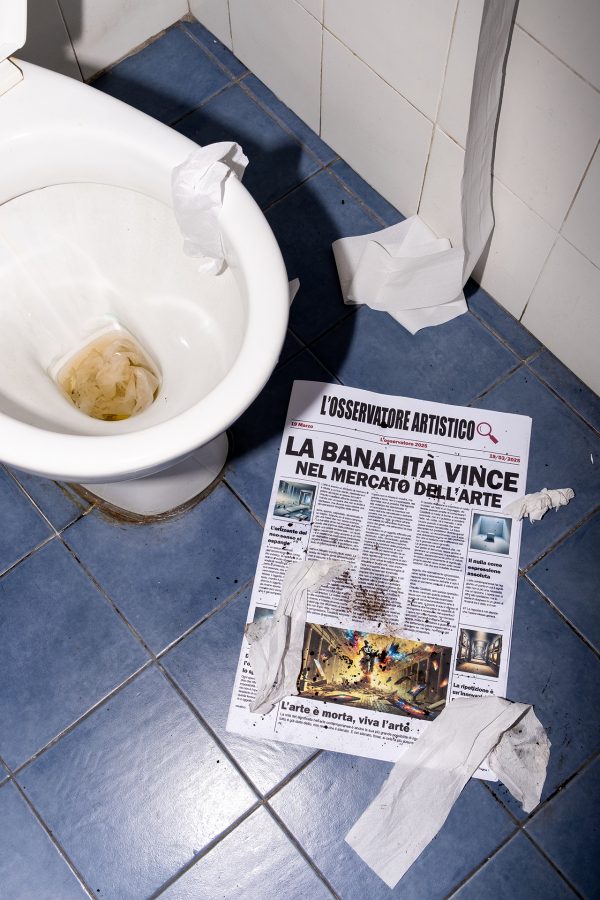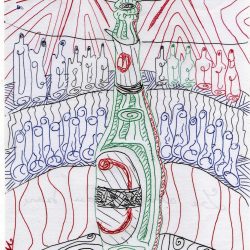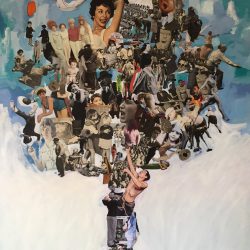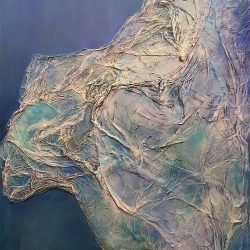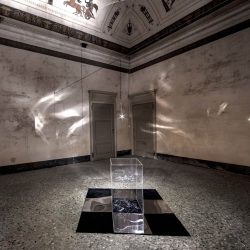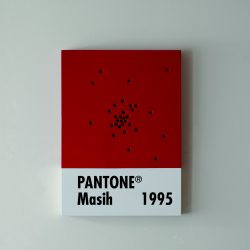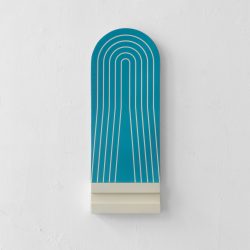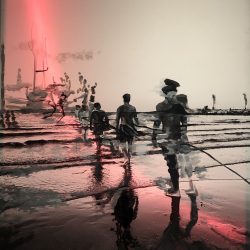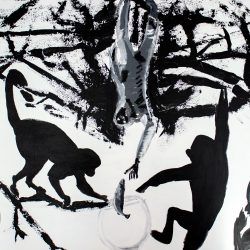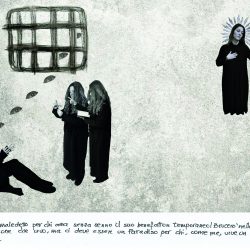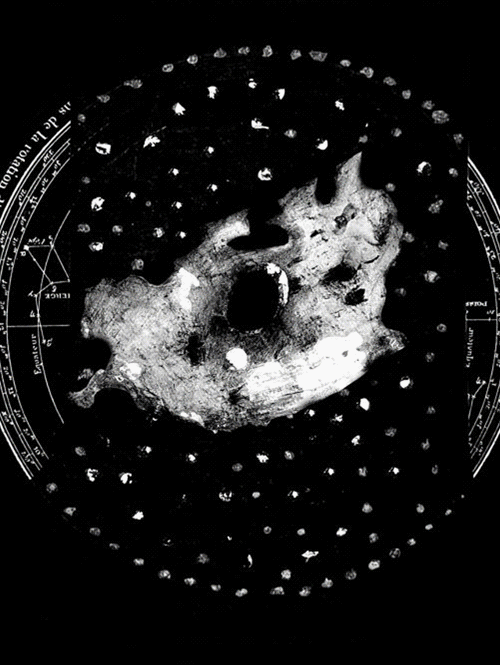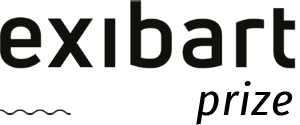work
LA BANALITÀ VINCE NEL MERCATO DELL’ARTE
| category | Photography |
| subject | Political / Social |
| tags | Politica, Mercato, Arte, Mercato dell'arte, Sociale |
| base | 50 cm |
| height | 70 cm |
| depth | 0 cm |
| year | 2025 |
Is art still a territory of research, or has it been reduced to a sterile echo, doomed to endlessly repeat the same formulas?
Claudio Castilletti tackles this question with a work that does not simply declare but becomes itself a tangible demonstration of the drift of contemporary art. A newspaper on the ground—dirty, trampled, forgotten in a bathroom. Yet, printed on it is a phrase that leaves no escape: “Banality wins in the art market.”
What at first glance might seem like an accidental scene—a newspaper casually fallen next to a toilet—is actually a meticulous construction, an aesthetic device that raises fundamental questions. The newspaper, a symbol of information and cultural dissemination, is stripped of its original function and relegated to mere visual waste. The choice of the bathroom as the setting is not random: it is a space of the most intimate routine but also of indifference, a place of transit where everything is consumed and then discarded, forgotten.
The footprint on the newspaper is a mark of erasure, an unconscious gesture yet powerfully evocative. It is not merely the image of a trampled object but a visual representation of the attitude with which artistic discourse is approached today. Criticism gives way to superficiality, the market swallows up research, and the artwork becomes merchandise to be sold rather than a tool for thought. Art is no longer seen—it is ignored.
In this composition, Castilletti subverts the very concept of exhibition: the artwork is not displayed but thrown on the ground; it is not framed but dirtied; it is not protected but exposed to the violence of indifference. This operation follows the path of conceptual and Arte Povera movements but with a postmodern awareness: today, criticism of art no longer manifests through provocative gestures but through surrender to the obvious.
The newspaper is the epitome of an ephemeral object: it is produced, distributed, read, forgotten, discarded every day. Within this cycle of information, the artwork becomes a metaphor for contemporary artistic production, where value is no longer determined by real critical depth but by the speed with which an artwork is consumed. Just as news becomes obsolete in a matter of hours, art is subjected to the same logic of accelerated consumption: the market imposes increasingly faster rhythms, and what does not adapt is ignored.
But Castilletti does not merely acknowledge this reality—he stages it with surgical precision. The direct, cold, and relentless flash recalls forensic imagery, as if the artwork were evidence of a crime. A visual investigation that brings to light not only the fragility of artistic value but also the responsibility of the observer. Who trampled that newspaper? Who chose to ignore it? Who decided that its contents no longer deserve attention?
At the heart of this reflection lies a crucial question: if art is a language, who decides when it stops communicating? Castilletti confronts us with an uncomfortable truth: it is not the public, the critics, or the market that kills art. Art dies when we accept that it can be trivialized. The phrase printed on the newspaper thus becomes a warning, not just a statement but a performative act realized through the very indifference with which the newspaper is ignored.
The great irony of this work is that, in its act of denunciation, it generates a paradox: the trampled newspaper, seemingly worthless, suddenly gains significance precisely because it is placed under scrutiny. What was invisible becomes visible. The audience, forced to look at an object they would normally ignore, is prompted to reconsider their relationship with the art system and how artistic value is constructed.
With this operation—minimal yet powerful—Claudio Castilletti leaves us with an essential question: how much of what we consider art is truly art, and how much is merely the reflection of a system that has lost the ability to distinguish the necessary from the superfluous? The work does not provide answers or solutions; like an open-ended investigation, it invites the viewer to observe what usually goes unnoticed and to wonder if, in doing so, their perspective has already changed.
Technique: Digital photography printed on Mille Punti paper mounted on Dibond.
Claudio Castilletti tackles this question with a work that does not simply declare but becomes itself a tangible demonstration of the drift of contemporary art. A newspaper on the ground—dirty, trampled, forgotten in a bathroom. Yet, printed on it is a phrase that leaves no escape: “Banality wins in the art market.”
What at first glance might seem like an accidental scene—a newspaper casually fallen next to a toilet—is actually a meticulous construction, an aesthetic device that raises fundamental questions. The newspaper, a symbol of information and cultural dissemination, is stripped of its original function and relegated to mere visual waste. The choice of the bathroom as the setting is not random: it is a space of the most intimate routine but also of indifference, a place of transit where everything is consumed and then discarded, forgotten.
The footprint on the newspaper is a mark of erasure, an unconscious gesture yet powerfully evocative. It is not merely the image of a trampled object but a visual representation of the attitude with which artistic discourse is approached today. Criticism gives way to superficiality, the market swallows up research, and the artwork becomes merchandise to be sold rather than a tool for thought. Art is no longer seen—it is ignored.
In this composition, Castilletti subverts the very concept of exhibition: the artwork is not displayed but thrown on the ground; it is not framed but dirtied; it is not protected but exposed to the violence of indifference. This operation follows the path of conceptual and Arte Povera movements but with a postmodern awareness: today, criticism of art no longer manifests through provocative gestures but through surrender to the obvious.
The newspaper is the epitome of an ephemeral object: it is produced, distributed, read, forgotten, discarded every day. Within this cycle of information, the artwork becomes a metaphor for contemporary artistic production, where value is no longer determined by real critical depth but by the speed with which an artwork is consumed. Just as news becomes obsolete in a matter of hours, art is subjected to the same logic of accelerated consumption: the market imposes increasingly faster rhythms, and what does not adapt is ignored.
But Castilletti does not merely acknowledge this reality—he stages it with surgical precision. The direct, cold, and relentless flash recalls forensic imagery, as if the artwork were evidence of a crime. A visual investigation that brings to light not only the fragility of artistic value but also the responsibility of the observer. Who trampled that newspaper? Who chose to ignore it? Who decided that its contents no longer deserve attention?
At the heart of this reflection lies a crucial question: if art is a language, who decides when it stops communicating? Castilletti confronts us with an uncomfortable truth: it is not the public, the critics, or the market that kills art. Art dies when we accept that it can be trivialized. The phrase printed on the newspaper thus becomes a warning, not just a statement but a performative act realized through the very indifference with which the newspaper is ignored.
The great irony of this work is that, in its act of denunciation, it generates a paradox: the trampled newspaper, seemingly worthless, suddenly gains significance precisely because it is placed under scrutiny. What was invisible becomes visible. The audience, forced to look at an object they would normally ignore, is prompted to reconsider their relationship with the art system and how artistic value is constructed.
With this operation—minimal yet powerful—Claudio Castilletti leaves us with an essential question: how much of what we consider art is truly art, and how much is merely the reflection of a system that has lost the ability to distinguish the necessary from the superfluous? The work does not provide answers or solutions; like an open-ended investigation, it invites the viewer to observe what usually goes unnoticed and to wonder if, in doing so, their perspective has already changed.
Technique: Digital photography printed on Mille Punti paper mounted on Dibond.



